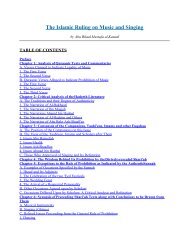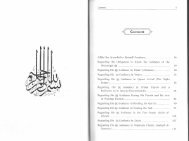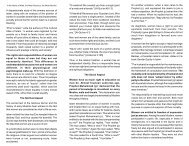Qabeelat TayybahStage 3Era <strong>of</strong> the Young Sahabah and the Tabi’eenNarration <strong>of</strong> the Hadeeth (41H-132H/ 662CE-753CE)This era began with the assassination <strong>of</strong> ‘Ali ibn Abi Talib by the Khawarij. Hassan, the son <strong>of</strong> ‘Ali, was putinto power afterwards. He then conceded to Mu’awiyah. Afterwards there was peace and the ‘ulema’ started anew age <strong>of</strong> knowledge. This is called the generation <strong>of</strong> the hadeeth. . ”“. “They never asked about Isnad (chain <strong>of</strong> hadeeth narrators) until the fitnah occurred. Only then did theystart asking. “Reveal to us the names <strong>of</strong> your narrators.” They look for Ahl as-Sunnah and accept theirhadeeth, and look for Ahl al-Bid’ah and reject theirs.” (Ibn Sireen)The fitnah…When Uthman was assassinated, the people had very different opinions as to how to solve the dilemma theynow faced. ‘Ali wanted to establish the Khilafah first and then avenge Uthman’s death. Mu’awiyah, ‘Amr ibnal-‘Aas, Talhah and az-Zubayr ibn al-Awwam were from Banu Umayyad, the tribe <strong>of</strong> Uthman, so they thoughtit was most important to first avenge Uthman’s death. A’isha wanted to get revenge as well. With the exception<strong>of</strong> Mu’awiyah, all the others decided to go to Iraq to go after the murderers <strong>of</strong> Uthman. When ‘Ali heard thenews, he went to Iraq to stop them. He intercepted them at a location close to Iraq where both sides agreed t<strong>of</strong>irst establish the Khilafah and then go after the murderers <strong>of</strong> Uthman. Though a treaty had been made, thepeople <strong>of</strong> Fitnah infiltrated both the armies <strong>of</strong> A’isha and ‘Ali at night and killed people from both camps. Thearmies saw this as a breach <strong>of</strong> treaty from the other side and combat took place.They then engaged in the “Battle <strong>of</strong> al-Jamal (the Camel)” because the camel <strong>of</strong> A’isha represented the flag <strong>of</strong>the battle. If the camel fell, then A’isha’s army had fallen. A’isha’s army was eventually defeated. ‘Ali then sentA’isha with some <strong>of</strong> his men back to Madinah. After this, she took herself out <strong>of</strong> the politics <strong>of</strong> the Ummah.‘Ali then went to Syria where he meet the army <strong>of</strong> Mu’awiyah and engaged in the “Battle <strong>of</strong> Siffin”. TheSyrians wanted to negotiate so a peace treaty was made between ‘Ali and Mu’awiyah even though noagreement was reached. Dissension broke out in the army <strong>of</strong> ‘Ali since some <strong>of</strong> ‘Ali’s supporters, who at firstdid not want to fight in the battle, now did not want to have peace. Thus, 10,000 men removed themselves fromthe army <strong>of</strong> ‘Ali and went to an area called Haruraa. They were later to be known as the Khawarij. Theydeveloped radical views. They called ‘Ali, Mu’awiyah, ‘Amr ibn al-‘Aas and Abu Musa al Ash’ari kuffar.Outwardly, these men looked very pious and more righteous than even the Sahabah. The Prophet predicted theircoming in the following hadeeth:TCE Notes Revolution 40
Qabeelat TayybahNarrated Abu Sa’eed Al-Khudri: “…Then the Prophet looked at him (i.e. that man) while the latter wasgoing away and said, "From the <strong>of</strong>fspring <strong>of</strong> this man there will come out (people) who will recite theQur'an continuously and elegantly but it will not exceed their throats. (They will neither understand itnor act upon it). They would go out <strong>of</strong> the religion (i.e. islam) as an arrow goes through a game's body." Ithink he also said, "If I should be present at their time I would kill them as the nation <strong>of</strong> Thamud waskilled"” (alBukhari).RasulAllah sal Allahu alayhi wa Sallam called the Khawarij “kilaabun naar- Dogs <strong>of</strong> the fire”‘Ali sent his cousin ‘Abdullah ibn ‘Abbas to negotiate and have intellectual debates with the Khawarij (i.e thosewho removed themselves from the army). 6000 men from amongst the Khawarij came back with ‘Abdullah ibn‘Abbas. It was the remaining 4000 that started to propagate the views <strong>of</strong> the Khawarij.The Sahabah did not consider the Khawarij as kuffar, but as Bugha or Ahlul-Baghi (transgressors). Therefore,the Sahabah decided to leave the Khawarij alone until they directly attacked the Sahabah. When the Khawarijkilled the son <strong>of</strong> Khabbab ibn Arat and his pregnant wife, the Sahabah went to battle against them. ‘Ali’s armyalmost completely exterminated the Khawarij in An-Nahrawan (Battle <strong>of</strong> Nahrawan) but a few escaped and fledto the East. The Prophet (Peace Be Upon Him) predicted that ‘Ali would fight the Khawarij. He gave adescription <strong>of</strong> a man that would be killed in the battle—a man with one hand whose flesh would hang down likea breast. After the battle, ‘Ali sent the people to find this man. When the man was eventually found, ‘AliRadiAllahu Anhu said: “Allahu akbar, sadaqa Rasulullah” and was relieved because it affirmed he wasfighting the right people.Narrated Abu Sa’eed Al-Khudri: “While the Prophet was distributing (war booty etc.) one day, DhulKhawaisira, a man from the tribe <strong>of</strong> Bani Tamim, said, "O Allah's Apostle! Act justly." The Prophetsaid, "Woe to you! Who else would act justly if I did not act justly?" 'Umar said (to the Prophet), "Allowme to chop his neck <strong>of</strong>f." The Prophet said, "No, for he has companions (who are apparently so piousthat) if anyone <strong>of</strong> (you compares his prayer with) their prayer, he will consider his prayer inferior totheirs, and similarly his fasting inferior to theirs, but they will desert <strong>Islam</strong> (go out <strong>of</strong> religion) as anarrow goes through the victim's body (games etc.) in which case if its Nasl is examined nothing will beseen thereon, and if its Nady is examined, nothing will be seen thereon, and if its Qudhadh is examined,nothing will be seen thereon, for the arrow has gone out too fast even for the excretions and blood tosmear over it. Such people will come out at the time <strong>of</strong> difference among the (Muslim) people and the signby which they will be recognized, will be a man whose one <strong>of</strong> the two hands will look like the breast <strong>of</strong> awoman or a lump <strong>of</strong> flesh moving loosely." Abu Sa’eed added, "I testify that I heard that from theProphet and also testify that I was with 'Ali when 'Ali fought against those people. The man described bythe Prophet was searched for amongst the killed, and was found, and he was exactly as the Prophet haddescribed him" (alBukhari).The remaining Khawarij then isolated themselves and created their own ideology, their own fiqh. They believedthat destroying the political leadership would resolve the problems they saw. So they made a vow to assassinate‘Ali, Mu’awiyah, and ‘Amr ibn al-‘Aas. One assassin went to Iraq to kill ‘Ali. Another went to Sham(Damascus) to kill Mu’awiyah. And a third went to Egypt to kill ‘Amr ibn al-‘Aas. ‘Abdur Rahman ibn Muljimmanaged to kill ‘Ali in Kufa, Iraq while the latter was leading Salatul Fajr. Mu’awiyah was injured in Damascusand ‘Amr’s deputy was killed instead <strong>of</strong> him since ‘Amr was not feeling well and so he sent his deputy to leadSalatul Fajr for him.TCE Notes Revolution 41













